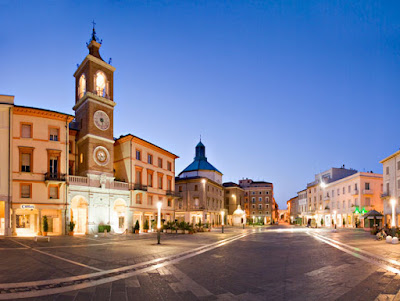I’M a beach bum when it comes to holidays. Give me the feel of sand between my toes and a glistening sea any time.
So I was sure I’d be in for a treat at the famous north-east Italian seaside resort of Rimini. But it turns out I’ve been missing a trick on my travels...
While the beach ticked most boxes, it was the surrounding area that stole the show... little-known gems that visitors often miss out on.
What made them even more of a joy was that our guide was so enthusiastic about them. Not bad, considering she’d probably seen them a million times – and she wasn’t even Italian.
Helga was a jolly, middle-aged woman who had fallen in love with the area – and an Italian man – some 20 years ago and moved from her native Germany. I didn’t get to meet her husband but it was easy to see what she saw in the region.
If you want to do justice to a trip here then it’s worth combining a few days on the beach by the Adriatic with some time in the hills or “back country”. You won’t need to waste time seeking out a beach.
“It stretches for about 70 miles,’’ Helga proudly informed me. And when she followed up by telling me “this is where Italians choose for their holidays’’, I was more than happy I hadn’t opted for a more obvious Italian break, like a weekend in Venice.
It’s not just the beach that seems endless here. There are enchanting medieval villages, historic landmarks and, of course, scrumptious local food and wine. The fresh pasta was to die for.
Then there are the wonderful stories and myths associated with some of the castles and old buildings – no doubt some of them inspired the revered Italian film-maker Federico Fellini, the director of La Dolce Vita, who grew up in Rimini.
The three main beach resorts are Rimini, the more exclusive Riccione about 15 minutes drive away, and Cattolica, heading a little south again. What I especially liked about the beaches was they were not only long but also extremely wide – plenty of space for some bucket and spade action with the toddlers and the sea is shallow too, so ideal for them.
The classy Riccione also has a long – and fairly new – pedestrian area alongside the beach, again great for a young family. Not so great (for the normal spender) is the shopping in Viale Ceccarini, with stores selling exclusive clothes with prices that could cover another holiday to somewhere like, er, Venice.
A tub of Italian ice cream can leave a bad taste at about a fiver a scoop. But the atmosphere of the place makes up for the high prices. The shopping can be costly in Rimini and Cattolica, too. Much better to head to a nearby mall for a better range of shops and ones that do not close for three to four hours in the middle of the day.
I preferred to get on my bike than window shop, taking in the historic heart of Rimini. Bicycles are a big way of getting around, as are scooters, and the exercise made me feel good about myself before my next large bowl of pasta and sauce.
Roman emperors were good judges of the finer things in life and most took a shine to Rimini – monuments such as the Arch of Augustus and the Tiberius Bridge still stand proud.
The Surgeon’s House in Piazza Ferrari is a must and was discovered only in 1989 when work began on a car park. The site shows the layout of a large Roman home where wounded soldiers would be treated and then recuperate – you can see the original equipment used at the nearby Archaeological Museum.
Rimini was the scene of much partisan resistance during the Second World War, which is worth reflecting on while having a coffee in its main square, Piazza Tre Martiri - named after three brave men hanged here by the retreating Nazis.
I needed something stronger than a coffee after trying on a jacket in one of the town’s top-end stores. It looked lovely in the window but didn’t quite fit me and at €600 (£540) that was a relief.
Italians are a smartly-turned out bunch and very hospitable, which is part of the reason I enjoyed a stroll around the charming medieval town of Santarcangelo, a 20-minute drive inland from Rimini. Check out if it’s a market day as this will add to the splendour and leave time to enjoy the numerous quaint shops. Shopkeepers often stand outside and politely offer to show you their goods – there is no pressure to buy but they are proud of the quality and rightly so.
I loved the small pasta shop, which was split into two – one half where three women were busy making it and the other where it was for sale.
Another favourite was an old cloth printing workshop boasting the oldest wheel mangle in the world – dating from the 1600s – used to smooth the cloth.
And make sure you visit the fascinating network of caves in Santarcangelo, whose origins are shrouded in mystery.
Why don’t more Brits head to this fine region? Well that’s another mystery...
rimini
Un pochino di sano campanilismo....



Nessun commento:
Posta un commento